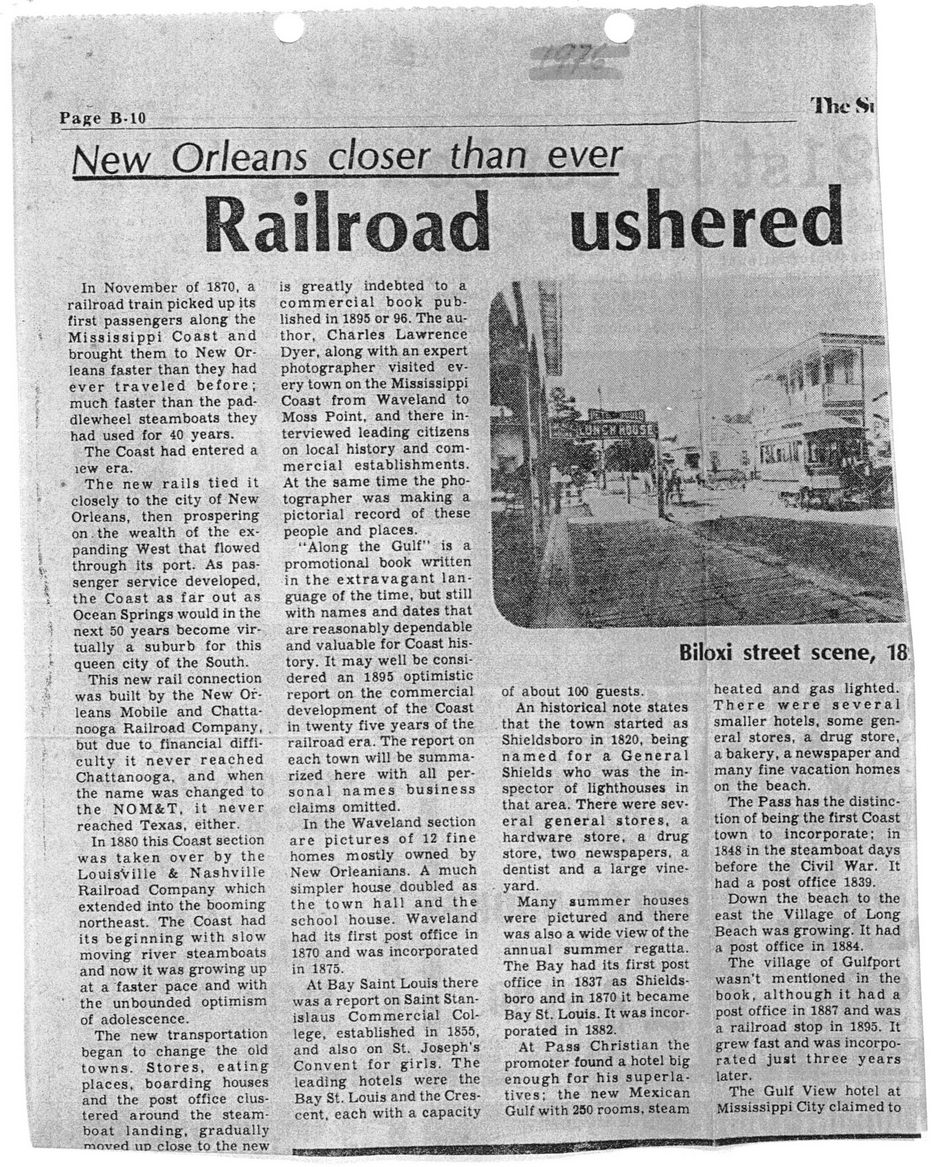This text was obtained via automated optical character recognition.
It has not been edited and may therefore contain several errors.
Page B-10 The S. New Orleans closer than ever Railroad ushered Biloxi street scene, 18 In November of 1870, a railroad train picked up its first passengers along the Mississippi Coast and brought them to New Orleans faster than they had ever traveled before; much faster than the pad-dlewheel steamboats they had used for 40 years. The Coast had entered a lew era. The new rails tied it closely to the city of New Orleans, then prospering on. the wealth of the expanding West that flowed through its port. As passenger service developed, the Coast as far out as Ocean Springs would in the next 50 years become virtually a suburb for this queen city of the South. This new rail connection was built by the New Orleans Mobile and Chattanooga Railroad Company, but due to financial difficulty it never reached Chattanooga, and when the name was changed to the NOM&T, it never reached Texas, either. In 1880 this Coast section was taken over by the LouisVille & Nashville Railroad Company which extended into the booming northeast. The Coast had its beginning with slow moving river steamboats and now it was growing up at a faster pace and with the unbounded optimism of adolescence. The new transportation began to change the old towns. Stores, eating places, boarding houses and the post office clustered around the steamboat landing, gradually is greatly indebted to a commercial book published in 1895 or 96. The author, Charles Lawrence Dyer, along with an expert photographer visited every town on the Mississippi Coast from Waveland to Moss Point, and there interviewed leading citizens on local history and commercial establishments. At the same time the photographer was making a pictorial record of these people and places. “Along the Gulf" is a promotional book written in the extravagant language of the time, but still with names and dates that are reasonably dependable and valuable for Coast history. It may well be considered an 1895 optimistic report on the commercial development of the Coast in twenty five years of the railroad era. The report on each town will be summarized here with all personal names business claims omitted. In the Waveland section are pictures of 12 fine homes mostly owned by New Orleanians. A much simpler house doubled as the town hall and the school house. Waveland had its first post office in 1870 and was incorporated in 1875. At Bay Saint Louis there was a report on Saint Stanislaus Commercial College, established in 1855, and also on St. Joseph's Convent for girls. The leading hotels were the Bay St. Louis and the Crescent, each with a capacity of about 100 guests. An historical note states that the town started as Shieldsboro in 1820, being named for a General Shields who was the inspector of lighthouses in that area. There were several general stores, a hardware store, a drug store, two newspapers, a dentist and a large vineyard. Many summer houses were pictured and there was also a wide view of the annual summer regatta. The Bay had its first post office in 1837 as Shieldsboro and in 1870 it became Bay St. Louis. It was incorporated in 1882. At Pass Christian the promoter found a hotel big enough for his superlatives; the new Mexican Gulf with 250 rooms, steam heated and gas lighted. There were several smaller hotels, some general stores, a drug store, a bakery, a newspaper and many fine vacation homes on the beach. The Pass has the distinction of being the first Coast town to incorporate; in 1848 in the steamboat days before the Civil War. It had a post office 1839. Down the beach to the east the Village of Long Beach was growing. It had a post office in 1884. The village of Gulfport wasn’t mentioned in the book, although it had a post office in 1887 and was a railroad stop in 1895. It grew fast and was incorporated just three years later. The Gulf View hotel at Mississippi City claimed to

Hancock County History General Newspaper Clippings Railroad-Feb-1976-(1)